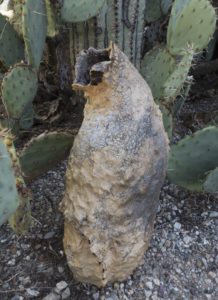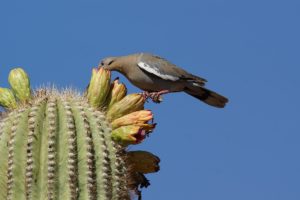Here lies hope

Woodpecker nursery
Photo by paradise birding.com
If you have ever held a swaddled newborn or can imagine several babies snugly bundled in one cradle, perhaps you can understand why we are so excited to have this object to share with you. It’s an old woodpecker’s nursery. Actually, you’re looking at more than a nursery, but an artifact representing a former partnership between two unlikely parties, the saguaro cactus and a desert dwelling woodpecker.
Let’s explain. Sonoran Desert habitats have few large trees in which birds can nest and seek protection from the harsh climate. The paloverde is one, but it’s iconic “tree” figure is not a tree but the Saguaro Cactus. These circumstances require desert-living woodpeckers to be creative in seeking housing.

Gila Woodpecker nestlings
Photo by Jim Burnes
If you are a woodpecker, breaking into a saguaro is relatively easy. But naturally the water-hoarding saguaro is unhappy to lose precious moisture caused by the woodpecker’s excavation; so it covers the surface of the “injury” with sap in order to stem the loss. Parent woodpeckers have learned to wait several months until the sticky sap dries before occupying the cavity. When they do, their nursery is a hardened, weather-resistant home! While living there, the woodpeckers consume many insect pests that may bring disease to the saguaro. Until the saguaro lays dead on the desert floor and exposes its wooden ribs and the shells of its bird nurseries, only exterior holes give a clue of the saguaro’s inhabitants.
Each saguaro that accommodates a woodpecker provides hope for the species’ future. This family of birds typically excavates new cavities each year, so by vacating their saguaro home and making another they provide a nursery or roost for smaller cavity nesting birds and wildlife, including the purple marten, small owls, bats, wood rats and insects. Even in a decayed state, the saguaro provides food and shelter to other wildlife.

White-winged Dove feeding on saguaro fruit
Photo by William Herron from Flagstaff, AZ
A saguaro can live for 100 years. In its lifetime, not only can it save countless species in the desert community, but its red fruit, flower pollen and nectar are food for them as well. Fruit eating wildlife reciprocate by distributing the saguaro’s seeds. In so doing they ensure its presence in the desert landscape. This single but surprising partnership ensures hope for wildlife and greater biodiversity in desert habitats.


Connect
Connect with us on the following social media platforms.